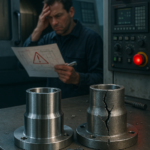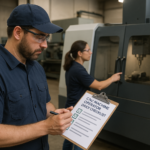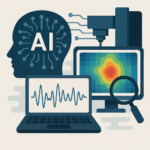In the ever-evolving world of CNC machining, downtime is the enemy of productivity. Every unscheduled stop costs time, money, and in some cases, customer trust. Traditional maintenance strategies—reactive or even scheduled preventive maintenance—are no longer enough. The future lies in predictive maintenance, a proactive approach powered by sensors, data analytics, and artificial intelligence (AI).
The Shift from Reactive to Predictive
Most CNC shops still operate on reactive maintenance (fix it when it breaks) or time-based schedules (replace it every 6 months). These approaches either come too late or too early. Predictive maintenance, on the other hand, uses real-time data and AI algorithms to determine exactly when a component is at risk of failure, optimizing uptime and minimizing unnecessary interventions.
1. Vibration Analysis: The AI-Powered Early Warning System
Rotating equipment such as spindles and motors emit specific vibration patterns. When bearings start to wear or imbalance occurs, these patterns change. With vibration sensors mounted on key components, a CNC shop can monitor:
- Bearing wear
- Shaft misalignment
- Imbalance or looseness
AI enhances this process by continuously analyzing vibration charts and seeking subtle anomalies in the frequency spectrum that humans might miss. Machine learning models learn from historical vibration data to detect early signs of failure—even before traditional thresholds are crossed.
2. Thermography: Intelligent Heat Signature Monitoring
Infrared thermography is a non-contact method that detects abnormal temperature rises in electrical panels, motors, and mechanical parts. It can uncover:
- Electrical overloads
- Bad connections
- Overheating spindle bearings
AI can automatically analyze thermal images (heatmaps), identify hotspots, compare patterns against known failure modes, and generate prioritized alerts. This transforms a manual inspection tool into an intelligent, continuous monitoring system.
3. PLC Integration: Feeding the AI Engine
Modern CNC machines come with PLCs (Programmable Logic Controllers) that already monitor hundreds of variables: axis loads, motor current, coolant flow, temperature sensors, alarms, and more. When this data is streamed to an AI-powered system or centralized CMMS (Computerized Maintenance Management System), it enables:
- Real-time, cross-variable anomaly detection
- Machine learning models to forecast failure probabilities
- Dynamic maintenance scheduling based on actual risk, not calendar days
4. AI-Based Monitoring: Pattern Recognition at Scale
AI systems excel at pattern recognition across massive datasets. When fed historical and real-time machine data, they can:
- Detect nonlinear trends and outliers in vibration, temperature, and load data
- Predict failures before symptoms are visible to operators
- Classify anomalies and recommend root causes based on learned experience
This turns raw sensor data into high-confidence predictions. For example, an AI may recognize a combination of rising spindle temperature, subtle vibration harmonics, and coolant pressure fluctuation as a precursor to bearing failure—weeks in advance.
Final Thoughts
Predictive maintenance isn’t just a buzzword—it’s a competitive advantage. CNC shops that adopt AI-enhanced predictive systems will experience fewer breakdowns, lower maintenance costs, and better resource planning. It’s not about replacing human workers; it’s about empowering them with tools that offer superhuman pattern recognition and foresight.
The future of CNC is not just about cutting metal faster, but also about thinking ahead with intelligent systems. Predictive maintenance, driven by AI, is the cognitive layer of tomorrow’s CNC environment.











Thanks for your article on the traveling industry. I would also like to include that if your senior taking into consideration traveling, it can be absolutely crucial to buy travel cover for retirees. When traveling, golden-agers are at greatest risk of experiencing a professional medical emergency. Buying the right insurance coverage package on your age group can look after your health and give you peace of mind.
This clarifies a lot of my confusion on the topic.
sckbnu
I will immediately grab your rss as I can’t find your email subscription link or e-newsletter service. Do you’ve any? Kindly let me know in order that I could subscribe. Thanks.
Thank you a bunch for sharing this with all of us you actually recognise what you’re talking approximately! Bookmarked. Please also visit my web site =). We could have a link trade arrangement between us!
5t2hl5
I’m really loving the theme/design of your website. Do you ever run into any browser compatibility issues? A number of my blog readers have complained about my blog not working correctly in Explorer but looks great in Firefox. Do you have any advice to help fix this issue?
Hi my friend! I want to say that this article is amazing, nice written and include almost all important infos. I?d like to see more posts like this.
Wow! This can be one particular of the most beneficial blogs We’ve ever arrive across on this subject. Basically Great. I am also an expert in this topic so I can understand your effort.
It is truly a nice and useful piece of information. I am satisfied that you shared this helpful information with us. Please keep us informed like this. Thanks for sharing.
Your place is valueble for me. Thanks!?
7ljvkx
Excellent post. I used to be checking constantly this weblog and I am impressed! Very helpful info specially the last part 🙂 I care for such info a lot. I used to be looking for this particular info for a long time. Thanks and best of luck.